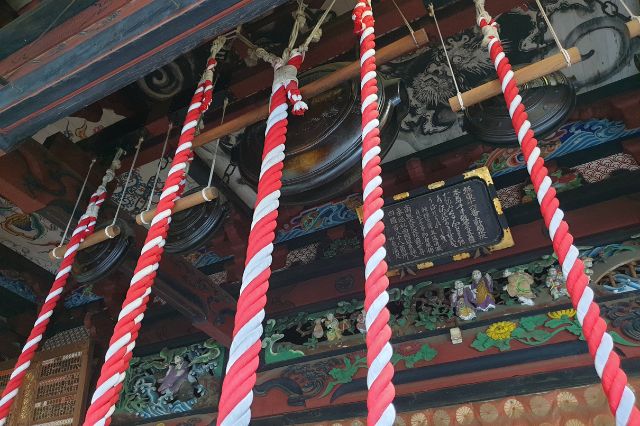
Surrounded by peaceful forested hills not far from the hot spring town of Ikaho in Gunma Prefecture, Mizusawa Kannon Temple holds a presence that feels both historic and very alive. This Buddhist temple, dedicated to the Bodhisattva of Mercy, has stood here for more than 1,300 years, quietly welcoming visitors who come to pray for health, protection on their travels, safe childbirth, and good fortune in daily life. Unlike many famous temples that are always crowded, Mizusawa Kannon Temple has a gentle, unhurried atmosphere that makes it easy to slow down and appreciate what is around you.
As you walk along the approach, the forest becomes part of the experience: tall cedar trees, soft moss underfoot, and the distant sound of a bell from within the grounds. The temple buildings themselves, the main hall, the unique hexagonal pagoda, and the bell tower, all show the refined style of the Edo period, when they were rebuilt with careful craftsmanship. Their deep red color stands beautifully against the green of the hillside, creating a perfect balance between architecture and nature.
Many travelers visit Mizusawa Kannon Temple while exploring Ikaho Onsen or the wider Gunma region, and it’s considered one of the most meaningful places to visit nearby. It is also part of the historic Kannon pilgrimage routes, which means the temple has been a trusted spiritual destination for countless generations. Whether you come with a clear wish in mind or simply to look around, the temple has a calming effect — the kind that gently reminds you to breathe, look up, and be present.
A Temple of Compassion, Carved into Time
DISCOVERING MIZUSAWA KANNON: A JOURNEY INTO HISTORY, NATURE & SPIRITUALITY
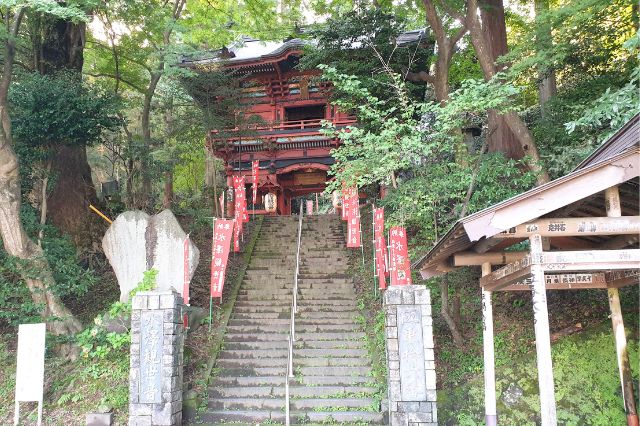
Mizusawa Kannon Temple is officially known as Gotokuzan Mizusawa-dera, and its story reaches back more than 1,300 years. It was established in Japan’s early historical eras with strong links to the imperial court, and from the beginning its purpose has centered on Kannon, the Bodhisattva of Mercy. Kannon represents compassion, healing, and protection — qualities that continue to draw visitors to this temple today.
At the heart of the temple is its principal image: an Eleven-Faced, Thousand-Armed Kannon. This sacred statue is not shown publicly, but worshippers believe its protective presence fills the grounds, offering comfort and guidance to those who come with prayers. Even without seeing it, you feel the influence of this spiritual figure in the stillness of the main hall, in the offerings laid before the altar, and in the way visitors pause with intention.
Over many generations, the temple has faced natural challenges, fires, and the passage of time. Each restoration — especially during the Edo period — has helped it remain both historically authentic and beautifully preserved. Today, Mizusawa Kannon stands as a place where ancient design, deep faith, and a peaceful natural environment remain perfectly in balance.
Crossing Through the Gate Into Sacred Space
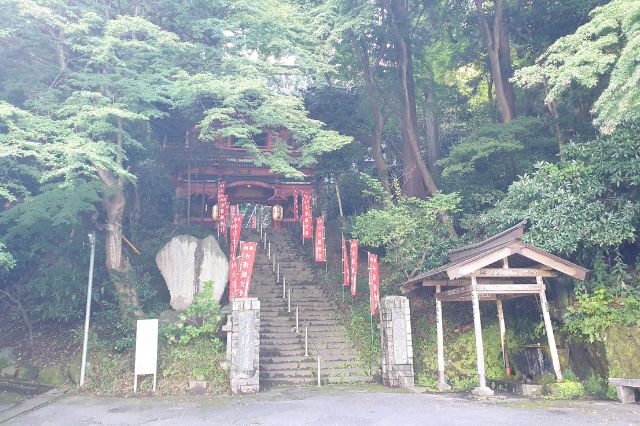
A vibrant vermilion gate stands as the temple’s entrance marker.
Passing through this torii symbolizes stepping away from the everyday world and into a sacred path. Here, the smell of wood and incense, the cool shade of trees, and the sound of nature instantly shift your pace and state of mind.
From the gate, stone steps encourage a slow, mindful climb. Lanterns and banners line the path, guiding visitors upward. The further you go, the deeper the forest envelopes you and invites you to breathe in a sense of calm.
Before You Enter the Sacred Space

Visitors to the chōzuya at the entrance of the temple take part in a traditional purification ritual before moving closer to the sacred halls. Water is scooped with a wooden ladle to wash the hands and gently prepare the mind and body for worship. This act marks the transition from everyday space into a more mindful, respectful state.
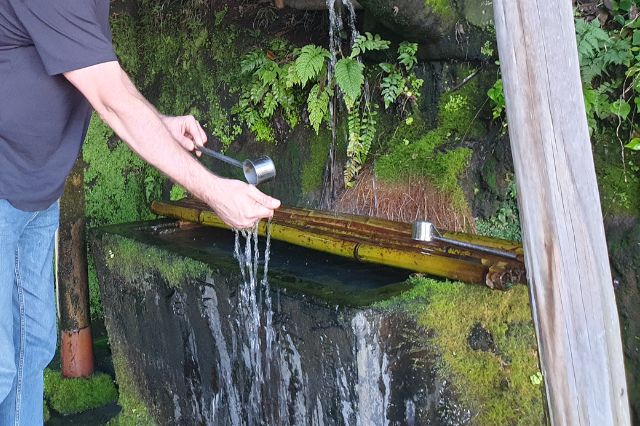
The mouth-rinsing portion of the ritual is symbolic, not for drinking. A very small amount of water is poured into the hand and used only to lightly rinse — never taken directly from the ladle or basin. Because of hygiene considerations, many temples now prioritize hand-washing only, and visitors can choose whether to include the mouth rinse at all.
If you feel unsure, you can simply perform the hand-washing step or bow briefly in acknowledgment of the ritual. Participation is voluntary and based on your own comfort. Please use the chōzuya thoughtfully and at your own discretion, as the temple and this website cannot take responsibility for any illness or issues resulting from the use of the purification water.
The Main Hall — The Heart of Devotion
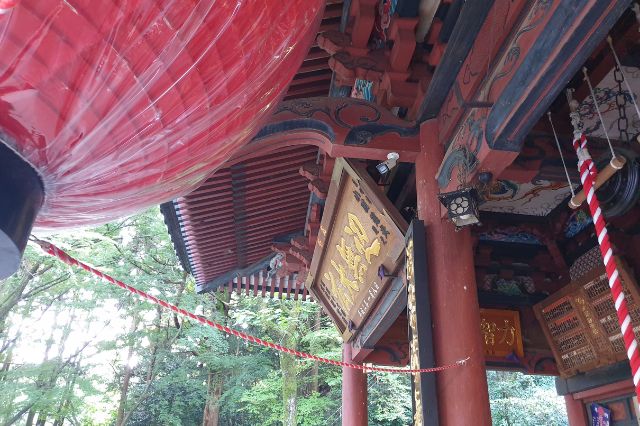
At the center sits the Main Hall — striking in deep red tones and supported by ornate wooden brackets. This building dates to the Edo period and is considered a cultural treasure of the local community.
Although the sacred statue inside remains concealed, people visit the Main Hall every day to offer prayers for family safety, health, well-being, and general life blessings. The sense of warmth and presence lingering in this hall is unmistakable — it feels like thousands of prayers held together under one roof.
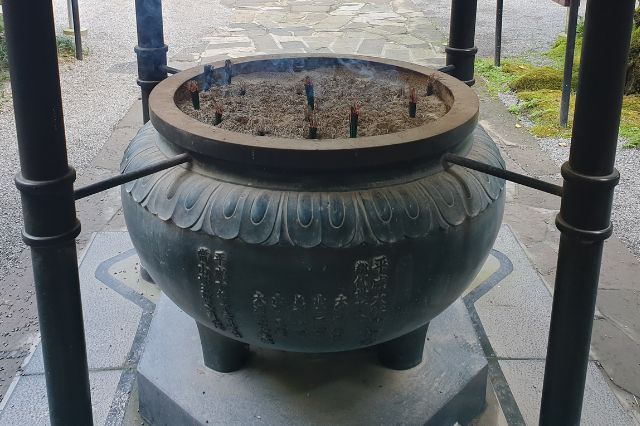
After purification, many visitors choose to offer incense as a way of sending their prayers into the spiritual space of the temple. Incense sticks can be purchased near the main hall, often with a small donation placed in the box. Selecting a stick is a quiet act — you think of the person or purpose you are praying for, and hold that intention as you light the tip.
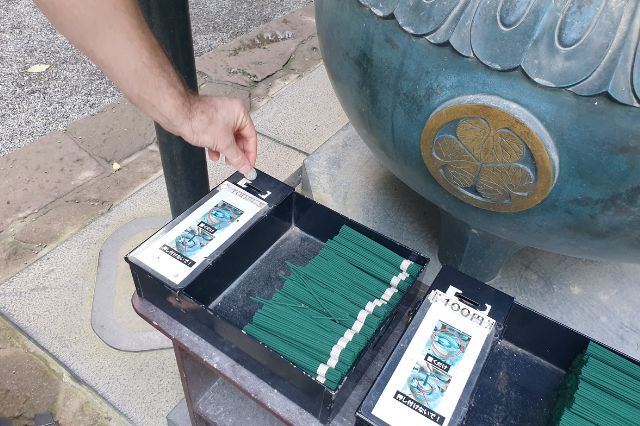
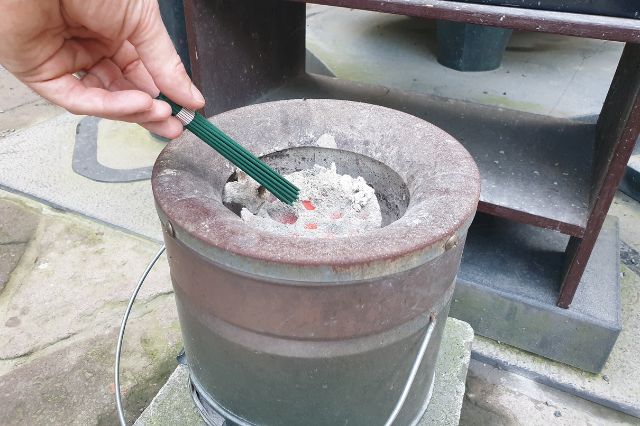
The incense is placed upright in a large ash-filled burner, where small flames already glow from offerings made by others. As the smoke rises, it carries individual wishes, gratitude, and hopes upward. For some, it is a prayer for health or safety; for others, a message of thanks or remembrance. There is something grounding about joining a tradition that has been repeated here day after day, generation after generation.
Even if the gesture is simple, standing there for a moment — watching the smoke drift into the air — reminds you that you are not alone in your thoughts. It is a shared ritual of care and connection.
UNIQUE Twin Hexagonal Halls at Mizusawa Kannon Temple, Gunma Japan
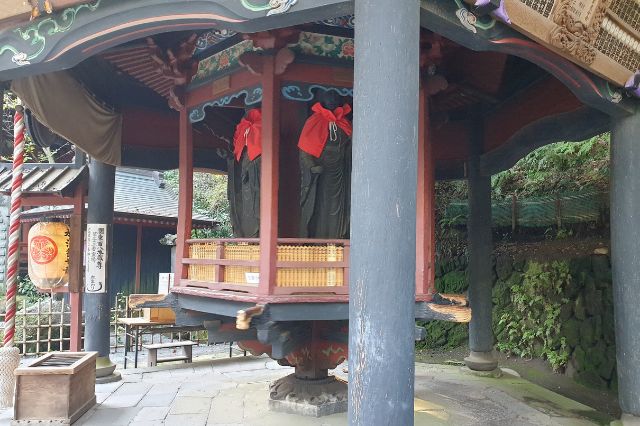
Mizusawa Kannon Temple is especially known for its two hexagonal buildings — a rare architectural style in Japan — each giving visitors a hands-on way to express their hopes and wishes. The first is the Hexagonal Two-Storied Pagoda (Rokkaku Nijūtō), built in the late 1600s. Inside are Six Jizō Bosatsu, guardians of protection and guidance across different states of existence. Visitors gently rotate the inner structure three times to the left while making a wish, and this symbolic action is believed to hold the same spiritual merit as reciting Buddhist sutras.
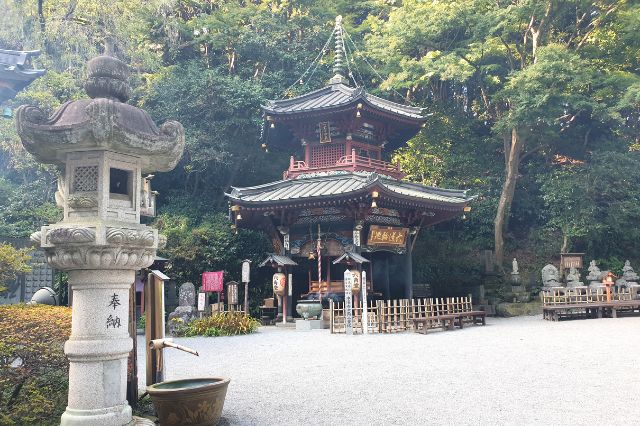
The second building is the Hexagonal Hall of Kobo Daishi (Rokkakudō), also a two-storey hexagonal structure. The first level enshrines the Six Jizō, while the upper level houses Dainichi Nyorai, the cosmic Buddha. This hall is also associated with the belief that turning the inner section three times helps open one’s luck and bring positive direction to life, drawing strength and comfort from the presence of Kobo Daishi.
The Six Jizō represented in these halls each protect one of the Six Paths (Rokudō) in Buddhist belief: the Hell Realm, the Hungry Ghost Realm, the Animal Realm, the Asura Realm, the Human World, and the Heavenly Realm. Their presence embodies the idea that guidance and compassion are available no matter where a person finds themselves — in hardship or in happiness.
Together, these two hexagonal halls highlight a meaningful tradition at Mizusawa Kannon Temple — hopes are expressed not only through spoken prayer but through gentle movement. Each turn connects you with hundreds of years of devotion, reminding every visitor that support and protection accompany them on their own life’s path.
The Temple Bell / Calling in the Present Moment
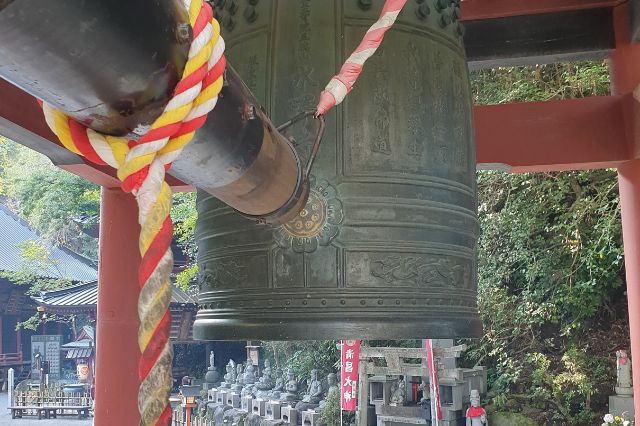
Among the trees at Mizusawa Kannon Temple you will find a traditional bell tower, known for its deep, powerful tone that resonates through the surrounding forest. Many visitors describe the sound as something that clears the mind and washes away stress, a moment of release that brings attention back to the present.
The bell is open for the public to strike, which is a rare experience at most temples in Japan. People travel here not only to listen but to participate, feeling the connection between their hands, the wooden striker, and the heavy, ringing bronze. It is believed that sounding the bell helps remove worries and refresh the heart before offering prayers to Kannon.
As the end of the year approaches, the bell becomes even more meaningful. During the traditional New Year’s Eve bell-ringing, large numbers of people gather to strike it and welcome a fresh start, a way to symbolically leave behind the hardships of the previous year and step into the new one with clarity. Surrounded by forest and history, the moment feels both personal and shared, carried forward by a rhythm that has been repeated for generations.
Whether you are visiting Mizusawa Kannon Temple as part of a day trip from Ikaho Onsen, exploring Gunma’s spiritual sites, or simply looking for a peaceful pause, taking time to visit the bell tower offers a grounding experience that stays with you long after the sound fades into the trees.
The bell is positioned on an elevated platform, so please take care not to slip or lose your footing while walking or taking pictures.
The Two Nio Guardians of Mizusawa Kannon Temple, Gunma Japan
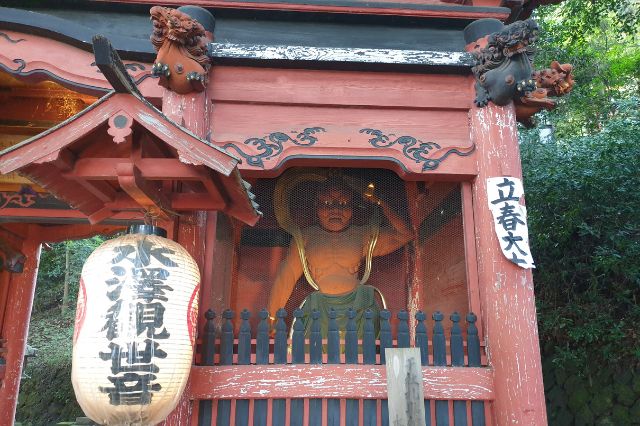
At the entrance of Mizusawa Kannon Temple in Gunma, Japan, one of the Nio guardian statues stands beside the inscription “立春大士”, which can be interpreted as a phrase symbolizing protection and renewal at the start of spring in the old Japanese calendar. Nearby, another inscription, “転禍為福” (meaning turning misfortune into blessing), expresses a hopeful message often associated with temple visits. These encouraging words highlight the role of the Nio as powerful protectors — reminding visitors that stepping through the gate marks a transition into a place where worries can shift toward positive energy.
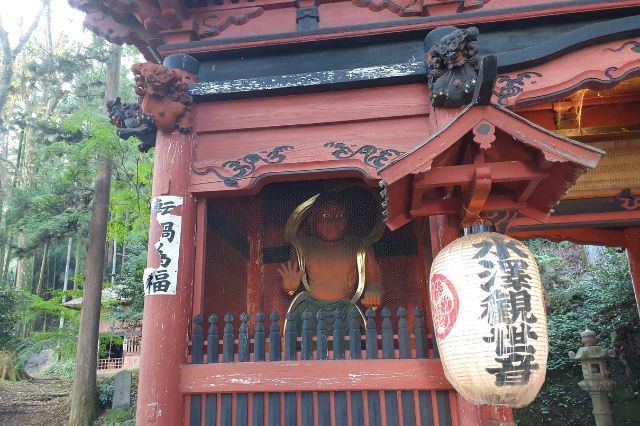
On the opposite side stands the second Nio guardian, completing the protective pair known as Kongō-rikishi in Japanese Buddhism. With its mouth closed in the traditional “Un” expression, this statue symbolizes the end of sound and the sealing of negative forces from entering the sacred grounds. Together, the two guardians define the boundary between daily life and spiritual space — offering both courage to begin and security to continue. Passing between them is a powerful reminder that Mizusawa Kannon Temple has long been a refuge for those seeking protection, courage, and peace.
A Sacred Pond of Water Spirits and Fortune
Within the grounds of Mizusawa Kannon Temple in Gunma, Japan, there is a quiet water garden dedicated to Ryūō Benzaiten (龍王弁財天), a deity believed to unite the protective power of the Dragon Kings of water with the good-fortune, wisdom, and artistry associated with Benzaiten. The spring found here has long been respected as sacred water connected to the temple, and many visitors come daily to draw it or to offer prayers while enjoying the calm surroundings. The pathways, stones, and statues in this area are arranged to honor the flow of water and the blessings it represents, from health and longevity to prosperity and creative success. Stepping into this garden invites people to take a gentle pause and reflect, supported by both nature and long-standing belief.
Entrance to the Ryūō Benzaiten Water Garden
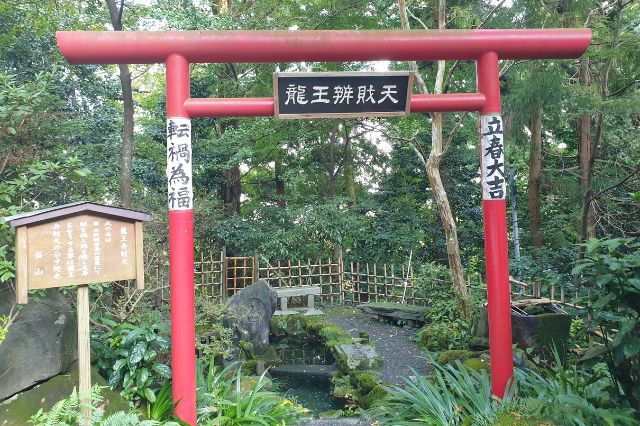
This red torii gate marks the entrance to the sacred water garden dedicated to Ryūō Benzaiten at Mizusawa Kannon Temple in Gunma, Japan. Passing beneath it represents a shift from everyday space into a quiet area where natural spring water has long been respected for its healing and life-supporting qualities. Signs beside the gate explain the significance of the sacred water connected with Benzaiten, inviting visitors to step forward with gratitude and prayer. The gentle forest light filtering through the trees creates a calm atmosphere, setting the tone for the spiritual experience waiting just beyond the gate.
Benzaiten Statue at the Sacred Spring
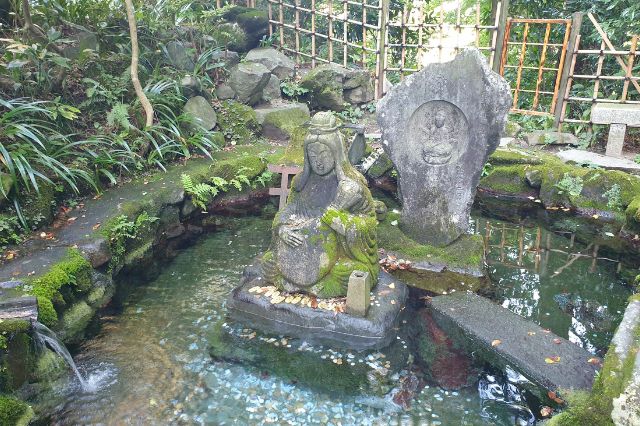
In the center of the water garden at Mizusawa Kannon Temple sits a serene statue of Benzaiten, the revered goddess associated with water, wisdom, music, and prosperity. Surrounded by the clear, sacred spring and lush moss-covered stones, the statue creates a calming presence that draws visitors to pause and reflect. Small coins placed in the water show how people quietly make wishes here — hoping for success in their creative paths, studies, or financial well-being. This peaceful spot highlights the long-standing belief in the blessings of water at Mizusawa Kannon, one of the spiritual treasures of Gunma, Japan.
Purification Basin Beside the Sacred Spring
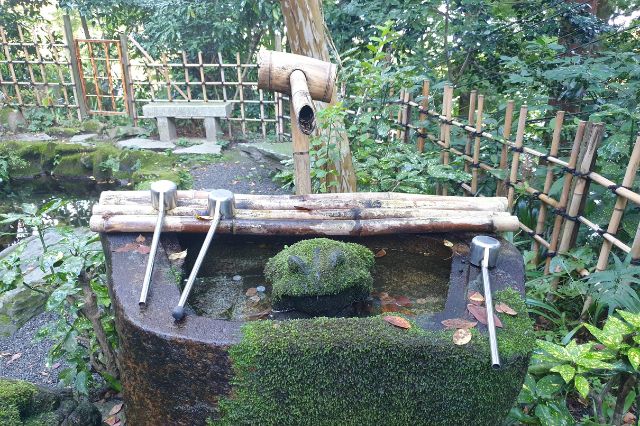
This stone basin is used for temizu, the traditional act of washing hands before making a prayer. Located inside the Ryūō Benzaiten water garden at Mizusawa Kannon Temple in Gunma, Japan, the basin uses the same spring water that is honored in this space. Visitors gently rinse their hands here as a gesture of clearing the mind and preparing respectfully before approaching the sacred statues. Today, mouth-rinsing is optional for hygiene reasons, making this a welcoming introduction to temple etiquette for new visitors. Surrounded by bamboo fencing and forest greenery, the sound of flowing water adds to the calming atmosphere of the garden.
Hōkai Ichijin — The Guardian Toad of Wish Fulfillment
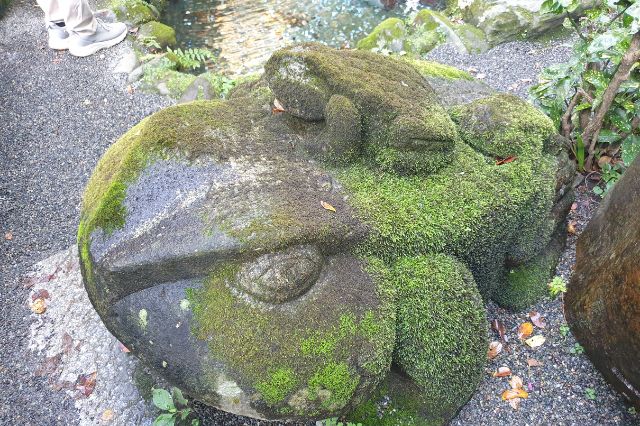
This moss-covered stone toad represents Hōkai Ichijin (豊家一神), a water spirit long connected to the mountains and springs of the region. A sign nearby explains that pouring a cup of water over its body is believed to help one’s wishes come true. Its weathered face and natural covering of moss show how it has quietly protected this space over many years. Toads are traditionally seen as symbols of “returning fortune” in Japan, and here at Mizusawa Kannon Temple, this guardian toad supports prayers for prosperity, safe travels, and the blessings carried through flowing water.
Harmony With Nature
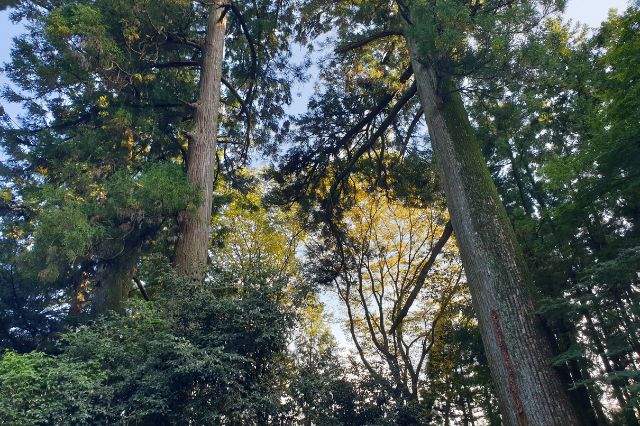
Mizusawa Kannon Temple blends beautifully into its forested environment. Moss grows across stairs and stones. Shade and light shift throughout the day, changing how the architecture appears. Birds, wind, and leaves create soundscapes that soften the senses.
Because of its hillside location, the temple feels like a secret sanctuary — embraced by nature rather than imposed upon it.
This perfect harmony between spiritual structure and living forest encourages a deep sense of grounding
A Practical Guide to Visiting Mizusawa Kannon Temple
Visiting Mizusawa Kannon Temple in Gunma, Japan is both peaceful and easy to arrange, whether you are staying in Ikaho Onsen or exploring from nearby JR stations. The temple grounds are free to enter, surrounded by fresh mountain air and quiet forest paths. With a little preparation and an understanding of basic temple etiquette, you can enjoy a meaningful and respectful experience while discovering this historic Buddhist site.
Location
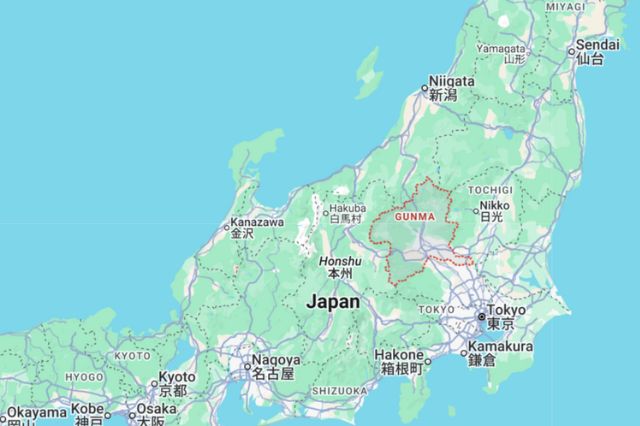
The temple is located in Ikaho-machi, Shibukawa City, Gunma Prefecture, Japan. Nestled on a hillside above the well-known hot spring town of Ikaho, the area offers a combination of nature, history, and cultural heritage. Use the address “214 Mizusawa, Ikaho-machi, Shibukawa-shi, Gunma” to navigate or plug it into your map app.
Access & Transport
By Train & Bus: From JR Shibukawa Station, take the Gunma Bus bound for Ikaho Onsen. Alight at the “Mizusawa Kannon” stop, then walk uphill through scenic forest paths to reach the temple grounds.
By Car: There is vehicle access via the mountain road from Ikaho. Parking is available near the temple, often free or with a small donation encouraged. The road may be narrow — drive carefully, especially in rainy or snowy seasons.
Walking from Ikaho: If you’re staying in the Ikaho Onsen area, you can also take a relaxed 15-20 minute walk up the approach road to the temple, passing local cafés and udon shops.
Cost & Fees
Entry to the temple grounds is free of charge. There is no standard admission fee. Donations (saisen) at the main hall or donation boxes are welcomed for upkeep, and optional charges may apply for guest services such as Goshuin (temple stamps) or special prayers. It’s a good idea to bring small Japanese yen coins, especially ¥5 and ¥10, if you would like to make offerings or take part in traditional practices.
Time Needed
Short visit: 30-40 minutes will give you a casual tour of the gate, main hall, and water garden.
Full visit: 1-2 hours allows you to explore all the halls (including the hexagonal pagodas), linger in the forest trail, take a moment at the pond, and enjoy a slower pace with photos or reflection.
In-depth visit: 2 hours or more if you move slowly, journal, practice meditation under the trees, or combine with a walk in the surrounding nature.
Time Needed
Speak softly: When you enter the temple precincts, particularly around the main hall and statues, lower your voice and conduct yourself calmly.
Purification: Use the chōzuya (water basin) at the entrance to wash your hands (and optionally rinse your mouth) before approaching the main hall. This gesture shows respect for temple customs.
Participating mindfully: If you wish, you may spin the pedestal inside the Hexagonal Two-Storied Pagoda (Rokkaku Nijūtō) or the Hexagonal Hall of Kobo Daishi — but do so gently and quietly, following the posted instructions.
Photography: Outdoor photography is generally permitted, but avoid shooting in indoor worship halls unless explicitly allowed. Also, please respect people in prayer and avoid using flash near sacred objects.
Dress & behaviour: You don’t need formal attire, but wearing modest, clean clothing and removing hats in main hall areas is appreciated. Avoid eating or drinking while standing in sacred zones, and keep your rubbish with you.
Nearby Experience & Food
Right below the temple approach is the famous Mizusawa Udon area, celebrated for its thick, chewy noodles served cold with dipping sauce. Many visitors pair their temple visit with a meal here — either before or after — enjoying the local flavor and relaxing atmosphere. Exploring the local shops that sell cedar souvenirs, charcoal-roasted coffee, and regional sweets is also a pleasant way to round out the trip.
Seasonal & Practical Considerations
Weather & terrain: Because the temple is on a hillside and includes forest paths, wear shoes with good grip — especially in rainy or snowy weather.
Crowds: Weekends and holidays can be busier, especially in autumn leaf-colour season or around New Year’s (for bell-ringing, etc.). Arriving early morning gives a quieter experience.
Restrooms & amenities: Basic restrooms are available near the temple entrance. There are cafés and restaurants around the Ikaho area — but bring essentials if staying later in the day.
Respecting nature: The grounds are home to moss, cedar trees and wildlife — please avoid stepping off paths, picking plants or leaving litter behind.
Connecting with onsen: If you’re staying in Ikaho, the temple’s serene nature walk pairs nicely with a soak in the hot springs afterwards — balancing spiritual calm with physical relaxation.
What Makes Mizusawa Kannon Temple Special Today
Mizusawa Kannon Temple continues to welcome visitors in a way that feels personal and human. Even without grand ceremonies or loud instruction, the environment itself teaches you how to slow down. The forest quiets your thoughts. The steps ask you to move with purpose. The sacred water invites you to pause and reset. Each space within the temple grounds is designed to support a gentle shift from everyday busyness toward a calmer state of mind.
The weight of more than a thousand years can be felt in its structures — in the worn stone paths, the smooth prayer railings, the soft creak of wooden floors. These traces of time show how many people have come here seeking clarity, comfort, or courage. And today, the temple still holds that role: a safe stop along the changing paths of life.
What stands out is not complexity but simplicity. Bowing before a hall, washing your hands at the basin, stopping to listen to wind move through trees — these accessible gestures invite reflection without pressure. They remind visitors that hope and peace can be found not only in rare miracles, but in small, intentional moments of attention.
Final Reflection
A visit to Mizusawa Kannon Temple offers a quiet pause in the middle of daily life. Nothing feels rushed here. The forest, the stone steps, and the gentle sound of water all encourage a slower pace and a clear mind.
There is no single way to spend time at this temple. Some visitors come to pray, some come for history or architecture, and others simply enjoy a peaceful walk among old trees. The experience is personal, and the temple respects that.
Traditions like washing hands, ringing a bell, or turning a wooden structure are simple actions — yet they give visitors a moment to reflect, set intentions, or appreciate being present. These small steps connect people with a long flow of history without needing to say many words.
When you leave, the calm feeling often follows. That quiet support is part of what keeps this temple meaningful today, just as it has been for many generations.



